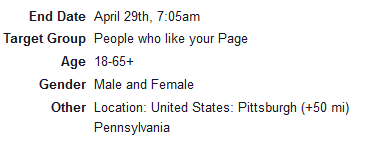One of the things that really annoys me about bloggers is that there is a lot of false advice going around about Facebook reach and advertising, and it's all pretty comical when you start to think about it. Why is that? Well, most of it amounts to Facebook having an agenda to screw you over.
There are ideas suggesting that your organic reach drops once you start advertising (it doesn't), thoughts that boosting doesn't perform as well as publishing ads direct from the Ads Manager (definitely not true for us), and that it is impossible to get a "good" advertising rates because Facebook wants to steal your money (albeit technically true since they are a business, it is not for that reason).
If you believe any of the above are true, I'm going to ask you to take the tin foil hat off for a moment while I propose a more likely scenario: perhaps your updates or audience suck(s)!
In the realm of reason, this one makes the most sense to me.Facebook is Not Out to Get You
It is a funny thing (and I say this as sarcastically as possible), but Facebook's algorithm is built around rewarding updates that perform well. That's all there is to it!
Have a share that is performing incredibly well and want to extend its reach? A boost is probably a good idea! Can you write a good copy and send it out to a very well defined audience? Ads Manager is perfect for optimizing around that. Not getting the results you're looking for? I hate to break it to you, but it is not Facebook's fault that you cannot engage your audience.
Contrary to popular belief, as a travel blogger you can make some rock star ads on Facebook for pennies per action if you know what you're doing, and the vast majority of that rests on you having great updates and an engaged audience to begin with.
Sadly, most do not have this, yet are delusional enough to think they do.Your Content Really is the Problem

The problem here is the fallacy that most bloggers think their content is good. It isn't.
Or, at the very least, it isn't for the audience you have built up on your page - which in a way is really all that matters.
This is especially true for travel bloggers who gallivant all over the world and think their thousands of Facebook fans are going to be interested in every single update they share. Again, they're not, and this stems from the fact that regular travelers do not plan 35 vacations in any given year and are simply not be interested about every thing you do, every thing you eat, or every place you visit.
The trouble here is you simply cannot connect with your audience all the time. It is true that your audience may care about some of the updates you publish, but you are really at a disadvantage because Facebook rewards accounts whose fans care about every update you publish. Naturally, this is a really high threshold for global travel bloggers and most do not even get close to the necessary levels to succeed.
So what do we mean by a good share? Well, if your organic reach is 10% of your audience size on average, and you have a post that ends up reaching 20%, this is not a good update in terms of your standard content- let's be honest and admit that it is only slightly better.
What we call a good share are updates that achieve, 50%, 75%, or even 100% organic reach within 24-48 hours of posting- which is something we achieve multiple times per week on our local blog's page with nearly 35,000 fans from our region (meanwhile we've never seen that on Living the Dream's page).
The difference between our local blog and a global site (like Living the Dream) is strikingly clear when we compare them side-by-side. Our content isn't any better locally than what we produce on our global site, but our audience is.
Rather than being made up of people from around the world, 80% of our fan base on our local blog is from the region our content is coming from! What happens from there? The vast majority of our fans are interested in everything we do, we get likes and comments on nearly every update right away, which triggers more reach in the algorithm, and results in more comments and shares over time.
Sure, a good percent of our content does top out at 5-20% reach (we are not immune from sharing less engaging updates either), but having this regional fan base helps us pick up frequent viral bursts triggering 100% organic reach, thousands of likes, tens of thousands of click-throughs to our site, and rapid growth of our Facebook page on the order of 2,000-4,000 new fans per month.
If you don't experience these, your algorithm results will keep dropping until you are in a pit that is almost impossible to come out of unless you build-up a whole new audience altogether (we've been there on our global site).
Like we said at the beginning of this post, there is no global Facebook conspiracy trying to get you to pay for ads. Your organic reach is not low because Facebook is wanting you to pay to play, it is low because your audience those updates are served to (who are typically your most engaged readers who happen to be online at the time of the update) simply do not care. Boosting doesn't help an update no one cares about, and no matter how good you think your update is if it isn't picked up by your audience it doesn't really matter in the long run- boosting or not.
But let's ignore the extreme downsides here about your awful content, and let's continue talking about what happens when you do get that kind of viral boom we talked about a few paragraphs ago. These updates are prime candidates for advertising and opens up a realm of new possibilities to keep the traffic going!
But What if You Have a Good Update? What Kind of Advertising Works?

So let's say you have a great niche with a well defined audience (preferably with a very focused geographic location) and you know what your fans absolutely love (and routinely get shares with 100% organic reach). What then?
Well, as with everything on this site we put together a bit of a test to see what advertising options work the best for us on our local blog. (It is worth noting all of the following were bid to optimize around impressions only and the tests were conducted in April 2016.)

The first test we did was creating custom ads through Ads Manager targeting users within 50 miles of our city, much like you would do when you advertise for page likes. As with page like ads, custom content ads for clicks to our site took quite a bit of time to optimize (on the order of three days) thanks to testing numerous images in A/B configuration, and averaged out at around 20 cents per click for every ad combination we came up with.
Overall, we were not impressed with these for the high cost as well as the fact that residual engagements such as likes, comments, or the possibility to invite non-connected users to our page was not present like they are in boosting. So while Ads Manager opens up a lot of fun advertising options (including advertising on set times / days of the week), we did not find anything to be cost effective enough to pursue them further.
Part of the problem here is you will most likely be creating an ad copy from scratch, with no insight on whether your audience will like it. Boosting, on the other hand, can be done after your audience has already engaged on an update, and gives you a good idea of what others will do when you throw money at it to extend the reach. (The earlier engagement also gives some social credibility if you have hundreds of likes, comments, or shares in a boost which you tend to not get on Ads Manager placements).
Even better? In our experience boosting does not have an optimization period where a few days worth of ad payments will get lower rates. So we scrapped this one pretty early on and moved on to boosting scenarios only.
The second test only used boosts and targeted users within our region (within 50 miles of our city) who were not connected to our page at all (about 600,000 users), just like the Ads Manager test above. In this test we had clicks to our site between 2 and 10 cents on good posts and 15 to 30 cents on bad posts. (Good and bad is relative here because every post performed quite well organically, but roughly half do not perform as well boosting for one reason or another that we cannot speculate on.) Overall, this was a marked improvement over the first test with the exact same targeting structure.

Our third test used the custom location targeting (50 miles) and also included only people who liked our page. This reduced our total reach capabilities from 600,000 down to approximately 20,000 users. From here we had clicks to our site between 1 and 1.5 cents on good posts and 5 to 10 cents on bad posts. Based on this test, it is probably safe to say there is merit in the name recognition of our brand with our current fans versus those who live in the region but do not know who we are.
The fourth test we performed was by boosting articles to fans of our page only (which was approximately 35,000 users), excluding the geographical restriction from the previous test. Our article shares ranged from 1.5 to 4 cents per click on good posts and 8.5 to 10 cents per click on bad posts. Although we expanded our available reach by 75%, some of our ads did not perform as well with those extra users who, although having liked our page already, do not live within the region our blog covers. I'm not surprised by that as they are less likely to act on our advice since they are not located in/near the city ( global bloggers, take note of that!).
Our fifth and final test expanded our advertising to include friends of fans without any geographic restriction. This expanded our reach from 35,000 users to approximately 500,000 users. Our article shares ranged from 2 to 6 cents per click on good posts to 8 to 30 cents on bad posts. As this expanded reach was similar to our first and second tests, I'm not surprised that our costs per click went up considerably in some cases. Brand recognition and regional interests matters quite a bit in advertising your content!
It may seem like we're making a fuss over the small details, but these subtle points really matter when it comes to Facebook advertising. If you are like us and spend $10/day in ads, you could get anywhere from 100 to 1,000 clicks to your site for the same amount of spending- so shaving off a penny per click can be huge in the long run.
So, What Should You Do?
In the first year of running our local blog's Facebook page, all of our advertisements were targeted at non-connected users within 50 miles of our city (roughly 600,000 people) as illustrated in test number two above. Although we showed above this was not the most cost effective for a larger Facebook page, it most certainly worked great when we were smaller.
Our theory for this was that our audience was small to begin with and paying to boost to them would do very little to grow our fan base. Sure, we probably would've received more click-throughs to our site at the time, but we wanted both clicks and page growth, making this a good option for accounts that do not have 5k, 10k, or even 30k fans to tap into with advertising spending.
Once you do start having a large, well-defined audience, you may wish to consider adjusting your target to add on people who already like your page on links while maintaining the previous structure on images.
The reasons for this are simple. Your fans already have name recognition with your brand and will be far more likely to click a link than a user who does not know who you are. We saw this above with the decrease in costs-per-click on our links when advertising to our fans over the fans + friends or non-connected users options. But by keeping your audience as non-connected users on images, you can also capture new fans who like the update as they scroll through (after all, what benefit are you getting by boosting an image to someone who already likes your page if they're not going to your site?).
Splitting your advertising between these two methods (in a percentage of your choosing- we do roughly 20% on images and 80% links) allows for your account to continually grow while also ensuring your popular links bring continued traffic to your blog. If you're going to pay for Facebook advertising, these are two results you should be seeing no matter what.
Of course I wouldn't recommend you take our word for it completely. If you are posting updates that fall into the categories we talked about above where advertising is incredibly beneficial, break out of your comfort zone and try a new ad to optimize it yourself!
Facebook's algorithm isn't out to get you, and one failed advertisement is not going to doom you with poor organic reach in the future. Only continually sharing poor content to disinterested fans can do that for you. So as long as you are pushing out great content, frequently getting reach in the 30%, 50%, or even 100% range, and keep sharing content daily, you do not have much to worry about.
So be proactive and make Facebook work for you!

Traveling Soon? Help Support Our Site!

